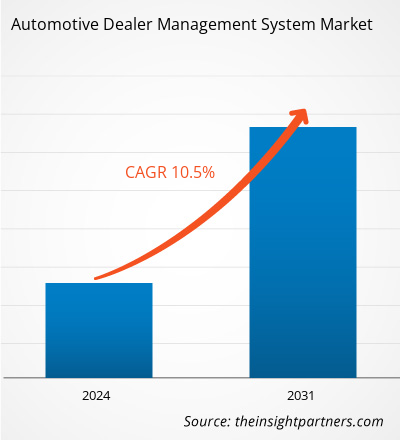汽车经销商管理系统市场规模预计将从 2023 年的 42.8 亿美元增至 2031 年的 95 亿美元。预计 2023 年至 2031 年期间市场复合年增长率为 10.5%。生成性人工智能 (AI) 与经销商管理业务的整合可能仍将是市场的一个关键趋势。
汽车经销商管理系统市场分析
由于汽车行业的技术进步不断进步,全球汽车经销商管理系统市场正在经历显着增长。全球数字技术的日益普及使汽车制造商能够应用复杂的解决方案。经销商管理系统是处理备件库存和维修订单的汽车公司的理想选择。该系统使用客户关系管理 (CRM) 和商业智能技术来监控制造商和客户关系。一些汽车经销商也使用该系统来处理库存和销售信息。经销商管理系统简化了消费者、经销商和原始设备制造商 (OEM) 之间的互动。该系统满足汽车零售业务的特定要求。许多组织使用无机和有机技术来发展其经销商管理系统公司在汽车市场的业务。2023 年 6 月,HBS Systems, Inc. 与 Record360 合作,以加快检查流程、消除损害索赔并管理其资产。Record360 和 HBS Systems, Inc. 合作利用 NetView ECO 经销商管理软件优化设备检查程序。
汽车经销商管理系统市场概况
汽车经销商管理系统 (DMS) 专为汽车行业的汽车经销商和大型设备制造商而设计。它是一套全面的工具,可帮助经销商在单一集成平台上管理其业务的各个方面。DMS 允许经销商从单一界面监控和管理其整个运营,自动执行任务并跟踪指标以实现最高效率。此外,它将经销商所需的所有工具和功能(包括财务、销售、车间、零件、库存和管理组件)整合到一个平台中。DMS 促进不同部门之间的有效沟通和协作,确保经销商业务的所有领域无缝协作。借助强大的 DMS,经销商可以加速销售流程并为客户提供增强的购买体验。
定制此报告以满足您的需求
您可以免费定制任何报告,包括本报告的部分内容、国家级分析、Excel 数据包,以及为初创企业和大学提供优惠和折扣
-
获取此报告的关键市场趋势。这个免费样品将包括数据分析,从市场趋势到估计和预测。
汽车经销商管理系统市场驱动因素和机遇
汽车行业的技术进步
汽车经销商对简化运营、有效库存管理以及顺畅集成销售流程的需求推动了对经销商管理解决方案的需求。汽车经销商管理系统用于潜在客户管理和销售分析。此外,这些解决方案还为经销商员工提供实时信息,使他们能够迅速响应客户问题、高效处理交易并妥善管理库存。它帮助他们提高生产力并增强客户体验。汽车经销商管理系统通过允许经销商跟踪客户联系人、管理潜在客户和提供量身定制的服务来改进 CRM。因此,他们可以提供更好的消费者体验并获得消费者忠诚度。
公司正在将其服务与经销商管理系统广泛整合。2024 年 3 月,通用汽车与汽车供应商 Magna 和咨询公司 Wipro Limited 合作,为汽车软件的买卖双方推出了一个名为 SDVerse 的虚拟市场。新的 B2B 平台有望有效地充当汽车应用商店,供汽车软件开发商向汽车制造商和其他潜在客户推销他们的产品。通用汽车声称,SDVerse 将克服当前嵌入式汽车软件购物和实施中的低效率,同时提供买卖双方可以信赖的透明店面。
自动驾驶汽车的出现
随着联网和自动驾驶汽车数量的 增长,全球汽车行业正在经历一场巨大的范式转变。由于自动驾驶汽车越来越受欢迎,经销商管理系统在运输和物流应用中的采用率预计将迅速增长,因为它可以快速分析车辆性能和效率低下之处。人们对自动驾驶汽车日益增长的倾向归因于技术改进、客户对全自动汽车的需求、价格实惠和安全性。汽车制造商正在增加对开发自动驾驶乘用车、商用巴士和卡车以及机器人出租车的支出。反过来,这有望在预测期内为汽车经销商管理系统市场增长提供丰厚的机会。
汽车经销商管理系统市场报告细分分析
有助于得出汽车经销商管理系统市场分析的关键部分是组件、行业垂直、部署和组织规模。
- 根据组件,汽车经销商管理系统市场分为软件和服务。软件部分在 2023 年占据了更大的市场份额。
- 根据应用,市场细分为库存管理、预约安排、客户关系管理、经销商跟踪等。客户关系管理部门在 2023 年占据了最大的市场份额。
- 根据部署情况,汽车经销商管理系统市场分为基于云和本地两种。2023 年,基于云的部分占据了更大的市场份额。
汽车经销商管理系统市场份额分析(按地区)
- 汽车经销商管理系统市场分为五大区域:北美、欧洲、亚太地区 (APAC)、中东和非洲 (MEA) 以及南美和中美。2023 年,北美占据市场主导地位,其次是欧洲和亚太地区。
- 预计从 2023 年到 2031 年,北美将占据全球汽车经销商管理系统市场的最大份额。由于对自动化和软件的高投资以及该地区经销商管理公司数量的不断增加,该地区占据了值得注意的全球市场份额。汽车制造商和汽车零部件经销商主要使用汽车 DMS 来管理和维护订单。汽车经销商利用现代 DMS 的功能来提高其经销商的生产力和效率。许多系统提供商正在开发其现有的 DMS,以获得更多来自汽车制造商的联系认证。2023 年 7 月,CDK Global Inc. 获得了宝马集团加拿大分公司的 DMS 提供商官方认证,包括宝马和 MINI 零售商。CDK Global Inc. 是宝马和 MINI 加拿大网络的领先 CRM 提供商。与汽车制造商的合作可以加强 CDK Global Inc. 在美国和加拿大市场的地位。
汽车经销商管理系统市场区域洞察
Insight Partners 的分析师已详尽解释了预测期内影响汽车经销商管理系统市场的区域趋势和因素。本节还讨论了北美、欧洲、亚太地区、中东和非洲以及南美和中美洲的汽车经销商管理系统市场细分和地理位置。

- 获取汽车经销商管理系统市场的区域特定数据
汽车经销商管理系统市场报告范围
| 报告属性 | 细节 |
|---|---|
| 2023 年的市场规模 | 42.8亿美元 |
| 2031 年市场规模 | 95亿美元 |
| 全球复合年增长率(2023 - 2031) | 10.5% |
| 史料 | 2021-2022 |
| 预测期 | 2024-2031 |
| 涵盖的领域 |
按组件
|
| 覆盖地区和国家 |
北美
|
| 市场领导者和主要公司简介 |
|
汽车经销商管理系统市场参与者密度:了解其对业务动态的影响
汽车经销商管理系统市场正在快速增长,这得益于终端用户需求的不断增长,而这些需求又源于消费者偏好的不断变化、技术进步以及对产品优势的认识不断提高等因素。随着需求的增加,企业正在扩大其产品范围,进行创新以满足消费者的需求,并利用新兴趋势,从而进一步推动市场增长。
市场参与者密度是指在特定市场或行业内运营的企业或公司的分布情况。它表明在给定市场空间中,相对于其规模或总市场价值,有多少竞争对手(市场参与者)存在。
在汽车经销商管理系统市场运营的主要公司有:
- CDK 全球有限责任公司
- 威普罗
- 甲骨文
- 思爱普
- 自动化
- 统治
免责声明:上面列出的公司没有按照任何特定顺序排列。

- 了解汽车经销商管理系统市场顶级关键参与者概况
汽车经销商管理系统市场新闻和最新发展
汽车经销商管理系统市场通过收集一手和二手研究后的定性和定量数据进行评估,其中包括重要的公司出版物、协会数据和数据库。以下列出了汽车经销商管理系统市场的一些发展情况:
- Dominion DMS 宣布与汽车行业首个也是唯一一个身份和保险验证及转移系统 Gather 建立战略合作伙伴关系。此次合作融合了 Gather 的革命性技术以及 Dominion DMS 的旗舰产品 VUE(一款云核心经销商管理系统)。Gather 的创新技术与 Dominion DMS 的 VUE 的整合代表了汽车行业的一个重要里程碑。这些解决方案共同帮助经销商提高运营效率、简化流程并提供卓越的客户体验
(来源:Dominion,新闻稿,2024 年 5 月)
- CDK 宣布延长与 Group 1 Automotive 的协议,Group 1 Automotive 是一家财富 300 强汽车零售商,在美国和英国拥有 203 家经销店,为其美国特许经营店提供 CDK Dealership Xperience,这是一个开放、集成的云原生平台,可实现经销商在数字世界中销售服务车和运营业务的方式的现代化。
(来源:CDK,新闻稿,2024 年 5 月)
汽车经销商管理系统市场报告范围和交付成果
“汽车经销商管理系统市场规模和预测(2021-2031)”对市场进行了详细分析,涵盖以下领域:
- 汽车经销商管理系统市场规模及全球、区域和国家层面所有关键细分市场的预测
- 汽车经销商管理系统市场趋势以及市场动态,如驱动因素、限制因素和关键机遇
- 详细的 PEST 和 SWOT 分析
- 汽车经销商管理系统市场分析涵盖主要市场趋势、全球和区域框架、主要参与者、法规和最近的市场发展
- 行业格局和竞争分析,涵盖市场集中度、热图分析、知名参与者以及汽车经销商管理系统市场的最新发展
- 详细的公司简介
- 历史分析(2 年)、基准年、预测(7 年)及复合年增长率
- PEST和SWOT分析
- 市场规模、价值/数量 - 全球、区域、国家
- 行业和竞争格局
- Excel 数据集
近期报告
相关报告
客户评价
购买理由
- 明智的决策
- 了解市场动态
- 竞争分析
- 客户洞察
- 市场预测
- 风险规避
- 战略规划
- 投资论证
- 识别新兴市场
- 优化营销策略
- 提升运营效率
- 顺应监管趋势























 获取免费样品 - 汽车经销商管理系统市场
获取免费样品 - 汽车经销商管理系统市场